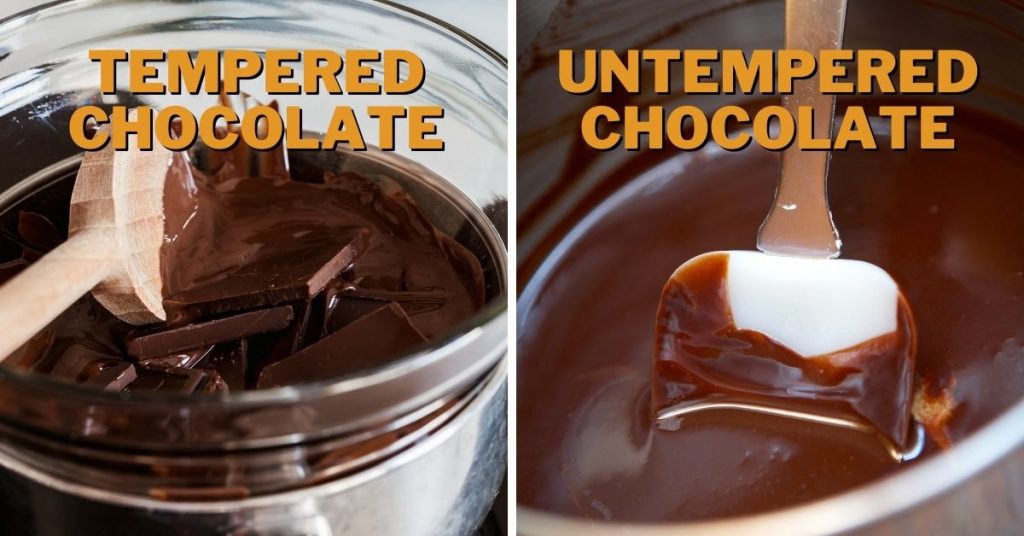Tempered Vs. Untempered Chocolate: Differences

Tempered or untempered, chocolate cannot under any circumstances taste bad. However, tempering is a technique used to modify the chocolate’s texture and consistency. Although same at first glance, tempered and untempered chocolate is quite different. So what are the differences between tempered and untempered chocolate?
Tempered chocolate has a glossy, shiny appearance, cracks when you bite it, has a longer shelf-life, dries quickly, and has a smoother texture. Untempered chocolate is matte and dull, soft when you bite it, lasts shorter, and its texture is chalky. Tempered chocolate dries more quickly, while untempered needs more time.
Although many consider them subtle, the differences between tempered and untempered chocolate aren’t subtle. It makes a big difference in the final result whether you temper your chocolate or not. It can improve or diminish your dessert.
Of course, you won’t end up with a horrible treat, but knowing the differences between tempered and untempered chocolate can’t hurt. Therefore, in the following paragraphs, I will explain how different tempered and untempered chocolate are and whether or not one is better.
Tempered Vs. Untempered Chocolate: What Are the Differences?
To better explain the differences between tempered and untempered chocolate, I must first explain tempering. There’s more than one chocolate tempering method, but all revolve around changes in the chocolate’s temperature.
To temper chocolate, you need to melt two-thirds and set aside one-third of the quantity you’re melting. Once you melt the chocolate, add the remaining third and mix well. This essentially combines hot and cold chocolate, modifying the overall structure.
The most significant difference between tempered and untempered chocolate is its appearance. While tempered chocolate is glossy, untempered chocolate has a duller and matte color. Not that untempered chocolate is less appealing because of that.
The second difference between them is the texture. Tempered chocolate is smooth and hard, but untempered chocolate is chalky and softer than tempered chocolate.
This is because tempered chocolate dries more quickly than untempered chocolate, not giving enough time for the molecules to separate. Therefore, tempered chocolate remains more stable and solid than untempered chocolate.
Due to the temperature changes during the making process, tempered chocolate has a longer shelf-life than untempered. While tempered chocolate would last for up to a year, untempered would be safe for a few months less.
When talking about hardening chocolate, tempered chocolate requires refrigeration, untempered doesn’t. Untempered chocolate can stay hard on its own, while tempered chocolate would melt sooner.
Reversely, when you coat, let’s say, strawberries with untempered chocolate, they will melt sooner than if you cover them with tampered chocolate.
Another difference is the setting. Tempered chocolate shrinks while it sets, and therefore it is much easier to make molds with it because you will easily take it out of the molds. On the other hand, untempered chocolate will be harder to remove.
Most of the store-bought chocolate has already been tempered. However, if you melt tempered chocolate, it will become untempered.
You cannot temper all types of chocolate. Tempered and untempered chocolate also differ by chocolate type. The tempering chocolate is also known as real chocolate, meaning it needs to contain cocoa butter.
The best chocolate for tempering is dark chocolate and couverture, made for this purpose. Still, you can temper any non-confectionery chocolate.
Confectionary chocolate isn’t good for tempering, and you shouldn’t experiment with it like this.

Tempered Vs. Untempered Chocolate: Which Is Better?
It wouldn’t be accurate to say that either is better because they are both at their best when properly used.
If we are talking about aesthetics, then tempered chocolate is the winner. It is excellent for coating or topping. Tempered chocolate is also far more suitable for chocolate decorations than untempered chocolate.
Because tempered chocolate needs a higher temperature to melt, the decorations will stay stable if the room temperature isn’t too high.
Tempered chocolate is perfect for chocolate-covered strawberries, truffles, chocolate bars, chocolate molds, chocolate-covered cookies, or anywhere you want to use two different textures. Tempered chocolate is not intended to be used for baking or filling, though it won’t be the worst thing to do.
Generally, you use tempered chocolate when you want your dessert to have an elegant appearance, you are serving it at room temperature, and you want to use the chocolate to top or coat your dessert.
Untempered chocolate takes the crown when used for baking or as filling. Its soft, dense, and chalky structure enriches the dessert’s consistency rather than enhances appearance.
If you want your dessert to melt in your mouth, then untempered chocolate should be your choice. It is excellent for ganache, chocolate-filled muffins, chocolate fudge, or chocolate fondant. Generally, whenever your recipe calls for milk, butter, eggs, sugar, and flour, feel free to use untempered chocolate in the equation.
The general rule says that you use untempered chocolate when you plan to eat your dessert more quickly, as it melts more rapidly than tempered chocolate. It also isn’t the best choice as decoration because it lacks the refinement of the tempered chocolate. However, if you are a fan of creamy, chocolate-filled desserts, untempered chocolate is the way.
In summation, tempered and untempered chocolate can do an excellent job for your dessert, even if you substitute one for the other. Still, tempered chocolate substitutes better for untempered than vice versa.
If you decorate or top your dessert with untempered chocolate, you should put some dry cocoa, chocolate sprinkles, or crushed nuts. That should stabilize the chocolate layer.
If you use tempered chocolate as a filling or an extra ingredient in your baked sweets, you should use it while it’s hot.
Anyway, both tempered and untempered chocolate shine best when you use them with the proper intention.
